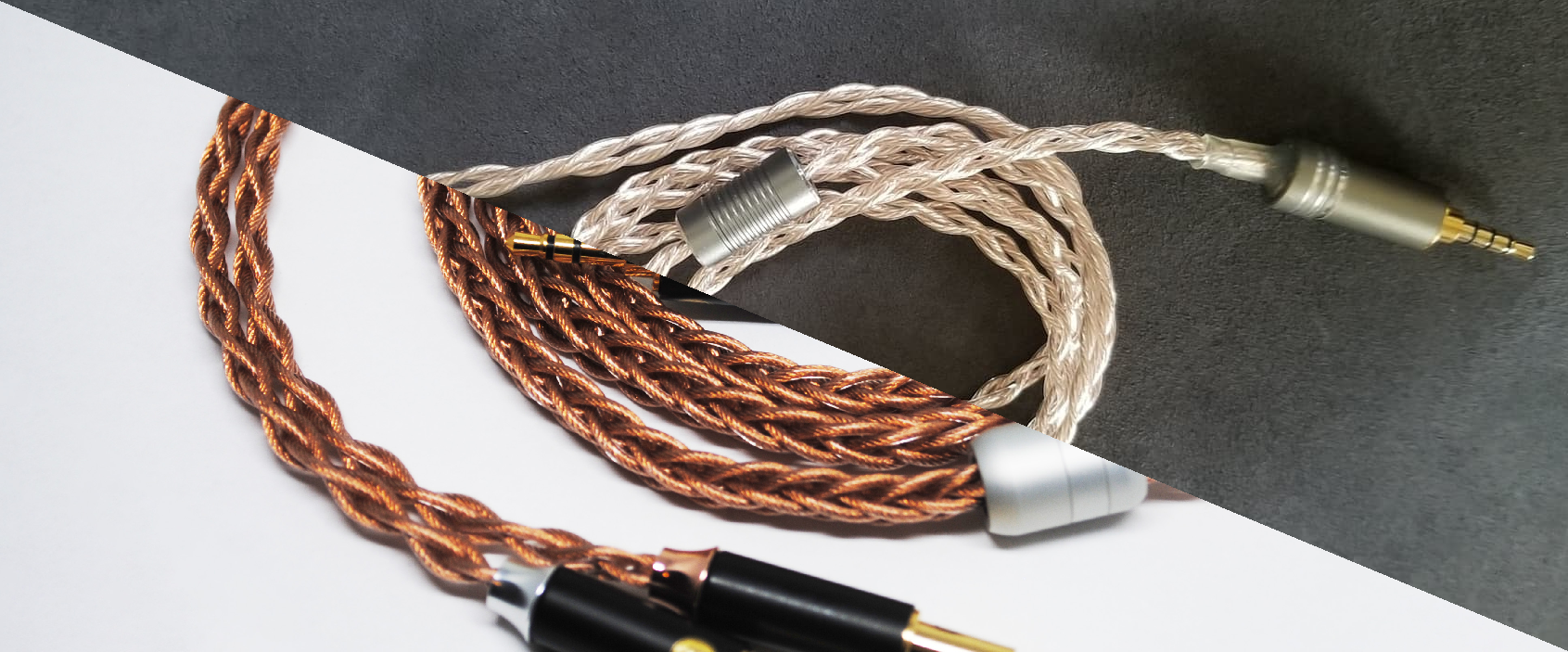Sampling from the wide gamut of cable offerings to fine tune a final soundscape.
During most of our audio journeys it is not uncommon to go through multiple chains and seemingly endless pieces of equipment. Upgrades, experimenting, changes in personal taste and individual needs. But what happens when you find those pieces that work so well together and are so so close to audio bliss? Perhaps, rather than chasing the next big thing, a new cable and some fine tuning will get you over the finish line.
Test Cables:
DHC Molecule Elite – 4 Wire Fusion: DHC Molecule Elite Headphone Cable – Double Helix Cables
PlusSound X8 – Copper: PLUSSOUND | X8 Series | Custom Headphone Cables
Test Equipment:
DACs & DAPs: Schiit Bifrost 2, Cowon Plenue S
Amps: Bottlehead Crack + Speedball (Jensen caps, Audio Note Volume Pot), Rupert Neve RNHP
Headphones: Focal Radiance, Sennheiser HD 6XX
Physicals
What started me on my cable search is pretty simple. This past year I decided after 5-10 years of being satisfied with my audio setups it was time to overhaul. For my travel setup I landed on a Focal Radiance, which has surprised me in many ways, but anyone who has owned a Focal headphone will know its Achilles’ heel. Miserable feeling stock cables! Audibly they pass, but physically the cable fights you like a cheap extension cord that has not been unraveled in 15 years and that is just not needed during travel, walks, and commutes. Thankfully both the Double Helix and PlusSound shame the stock cable’s build quality, feel, and aesthetics.
The DHC Molecule Elite sports a thinner round braid and smaller connectors which disappear nicely into the headphone connector sockets. It is solid built, extremely flexible, and easily pocketable. The silvery white cable stretched between the slightly darker metallic Eidolic connectors makes for a clean look and easy color matching. A small “Prion” decoration acts as a weight and keeps the cable where you need it. I did notice that the thick clear stress relief was not pin straight on one of the connectors, but this feels more like an OCD gripe on my end as it had zero affect on any functions.
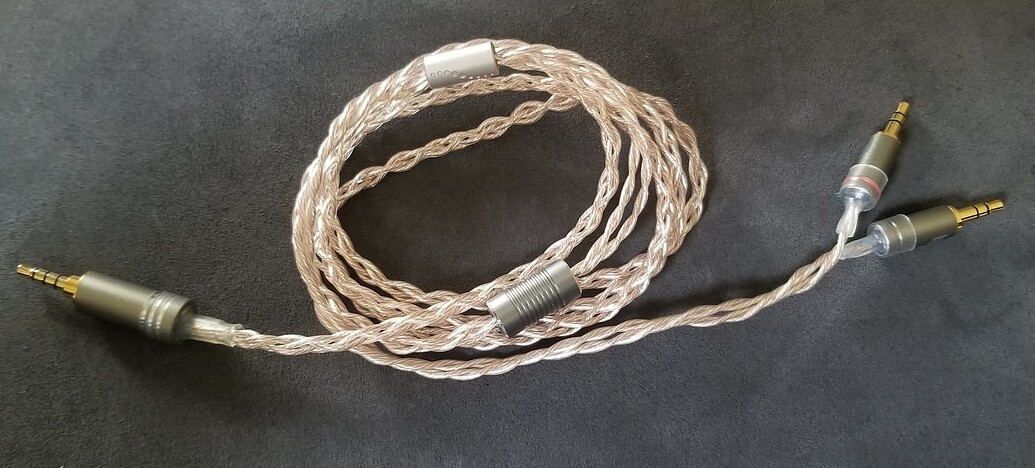
With it’s rich copper coloring, chainlike square braid, and stockier overall look, the PlusSound X8 is easily distinguished from the DHC. While still flexible, the PS was notably more stiff and lacked the scrunch-it-into-a-ball-and-throw-it-in-your-pocketiblilty, due in part to it sporting 8 wires. That is double the 4 wires of the Molecule Elite but it should be noted the X8 uses a slimmer gauge wire. The custom PS connectors are more substantial than the tidy Eidolics to the point the main body does not fit into the Radiance’s connector sockets. This is circumvented by extending the plug portion but ultimately it does not leave the neatest look as it always seems like the cable is not fully pushed in. The strain relief is also custom and gives a high end luxury look. I am not sure if the stiff taper relieves as much as the standard semi-flexible heat shrink wrapped ends, but it does keep it all neat.
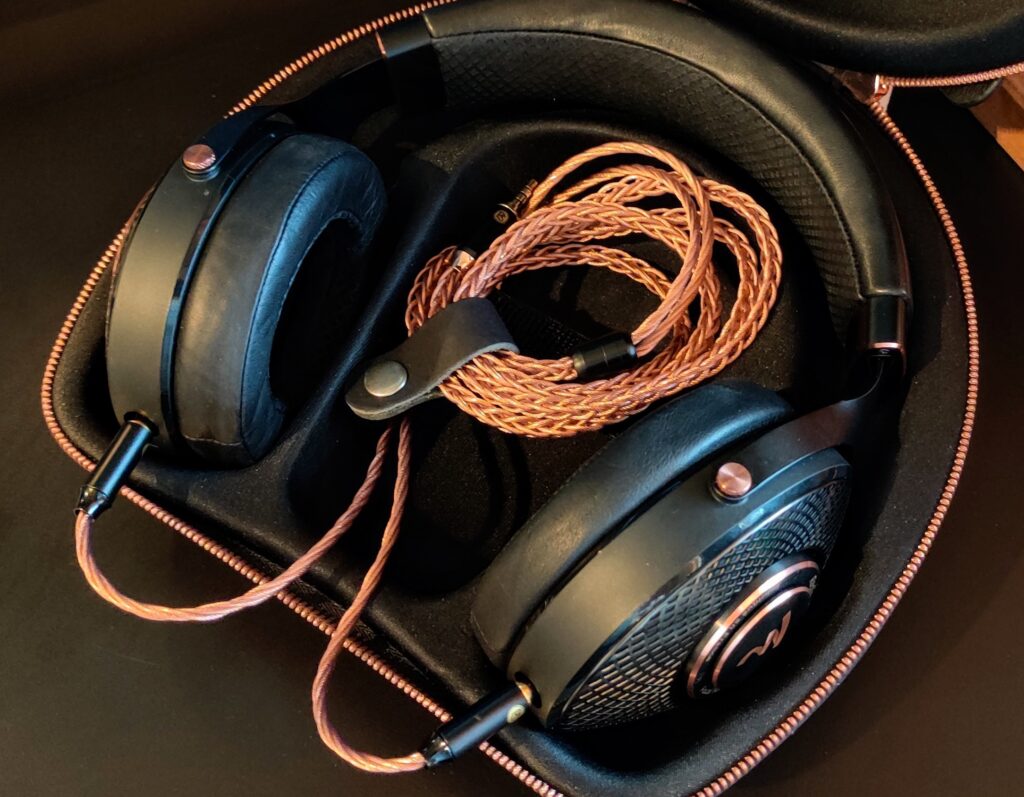
Sound
Although my main focus was to acquire a cable more fit for travel, why not fine tune some sonic characteristics while I am at it?
Out of all 3 cables the DHC Molecule Elite was able to bring out the most detail, resolution, and texture with all three aspects being a clear step or two above stock and a half step or so beyond the X8. It’s all very clean and with a bit of attention you can make out most of what is presented. Macro dynamics swing slightly beyond the stock cable which, when paired with the Radiance, really makes you want to tap your feet. Micro dynamics did feel a tiny bit flat but are covered well by the cable’s overall dynamic nature. With the DHC ME each piece of the musical composition is like a glossy, new, tall, glass vacuum tube. Imagine the classic promo pictures of tube amps. Some highly polished tubes are glowing bright enough to really catch your eye but there is no illumination of much else and it’s mostly black space between them. That glossy glassy feel with little to no room reverberation is the major characteristic I get from the DHC. It comes across in a squarely controlled bass with more mid punch than sub presence and upper mids and treble being much more forward and present. Like ringing glass, clean, no grit, straight lines with neatly round edges, a shine that catches your eye, and a clarity in the glass that helps reveal the highlighted details.
The PlusSound X8 lands on the other side of the spectrum from the DHC and it does not take analytical listening to hear it. The X8’s better detail, texture, and tactility is noticed and welcome against the stock cable but they barely miss the mark set by the DHC ME. Dynamics are more lively than the stock and DHC cables. Macro dynamics are displayed via big lively swings, while micro adds subtle dimension to previously flat passages. Once again, the Focal Radiance eats this up and those foot taps easily can turn into full body grooves. Presentation is where there is a definitive break away from the DHC. Unlike those tall glassy tubes juxtaposing a black backdrop, the X8 is a long forgotten room in a large abandoned mansion. It presents each piece like it is a hunk of grand furniture in the room, covered in some loose sprawling cloth. Their tail ends extend along the floor, overlapping, bouncing off the stage walls, coming back often on top of each other, that is, if they don’t keep going into another room affectively extending the soundstage. The swirling dust in the air reacts to sounds and movement but it is not thickening the air or creating any noise of it’s own. You jump on the centuries old couch and the floors and furniture let out pronounced sub bass creaks as it readjusts to holding weight. The old glass windows smooth out the bright light and you relax taking in the carved details of the rich mid mahogany mantle.
Notable Pairings
DHC Molecule Elite:
- BF2 -> BHC+SB -> HD 6XX: In general, the BHC chain quickly became a favorite of mine as it just spaces things out and the dynamics take you places. It is a little slower and less detail oriented but I would say it is my preferred way to explore classic rock. The DHC does not change this but the sound does starts closer to you while still extending deep. There seems to be a little compression around the mids but overall you will mostly notice an edgier outline around everything.
- BF2 -> RNHP -> HD 6XX: This was the best match for the DHC. I fully admit that the RNHP is a bit underpowered for the Sennheiser but the cans are so comfy it is a go to after a long day. The ME adds a lot that I otherwise only heard on the HD 6XX when pushed by a bigger amp. Increased touch and texture is immediately noticed and there is a little more definition all around. Smaller details seemed to be more present as well.
- Cowon Plenue S -> Radiance: This was the main chain I purchased the DHC for. I wanted to pull the Radiance’s treble closer as it sounded like it was always coming from down a hallway. And even though the Cowon has a great EQ and DSP suite, why not try to do that and some with a cable swap? Well, the synergy here was just a miss, and the DHC’s positives were overshadowed by a glaring in the higher vocal ranges. That glassy feel was overwhelming to the point backup vocals overtook the lead singer and some instruments, such as trumpets, caused immediate fatigue and discomfort. Even the usual great timbre was warped and it was hard to tell vocals and instruments apart. I do not blame the DHC here as any time equipment provides a more forward soundscape, the Focal Radiance can loose the smooth relaxing nature the headphone is known for.
PlusSound X8:
- BF2 -> BHC+SB -> HD 6XX: The PlusSound X8 shines here but it feels like it does not have to do much. It flows well with the deep, wide, dynamic nature of the Crack and it creates a real floating in the cosmos feel. Once again classic rock was king here. Any Zeppelin tracks where the band used room reverb to create space was a real treat. Echoes trailing out to into the blackness. It seemed much more like the cable was getting out of the way on this one and letting the tube goodness flow.
- BF2 -> RNHP -> HD 6XX: Not too much to say here. The X8 added a light dash more to technicalities than the stock cable, but it was not able to add enough to overcome the underpowered amp like the DHC did.
- Cowon Plenue S -> Radiance: I originally was worried that this combo would be too warm and smoothed over but this chain seems to love throwing curveballs. Here the Radiance leads the way and the Cowon and X8 lean in and support each other. The X8 adds dynamics to the flatter Cowon. The Cowon’s EQ adds some sparkle to the more relaxed X8, and most importantly, the EQ is able to nudge the Radiance’s recessed treble up to mid stage without pushing it to glare or fatigue levels. You end up with a smooth relaxed sound that rides along a backbone of big but natural dynamics while still keeping all the details. Everything here feeds off each other so well and it really pushes the chain to a sum greater than it’s pieces.
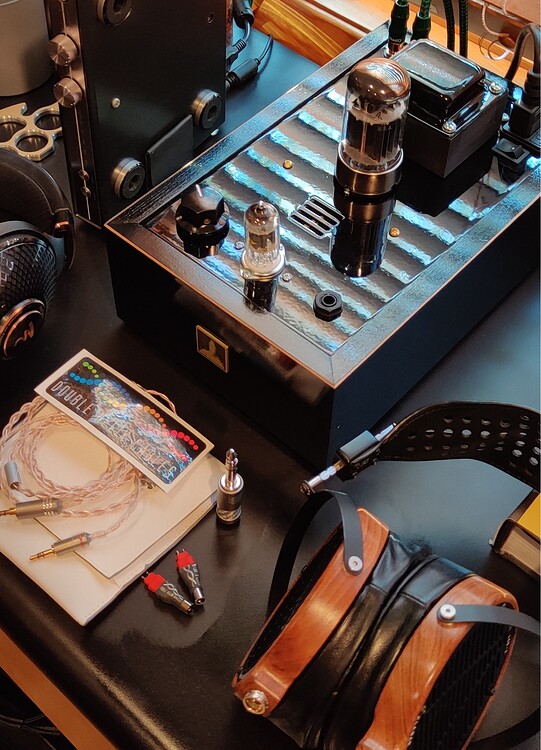
Notes & Concluding Thoughts
There has been a lot of discussion regarding cables and their place in audiophile setups. Tackling their physical and aesthetic aspects is the easy half. Do they look good, do they feel good, does it function well? For the stock Focal Radiance cable that started this all the answer was “Ehhh, kinda.” While the cable looked nice, it really was a little short and it had an elephants memory from the day it was folded up and put in it’s case. Both the DHC Molecule Elite and PlusSound X8 beat the butt off of stock in mostly everyway. Both do not keep a memory, both are much more flexible (the thinner DHC more so than the X8), and both are constructed with premium components that look the part. I also must highlight that the DHC Ultrashort Adapters are super solid and allowed me to use one cable across many different platforms and that really allowed me to stretch the initial cable investment. PlusSound does make adapters as well, but they were not on hand to test.
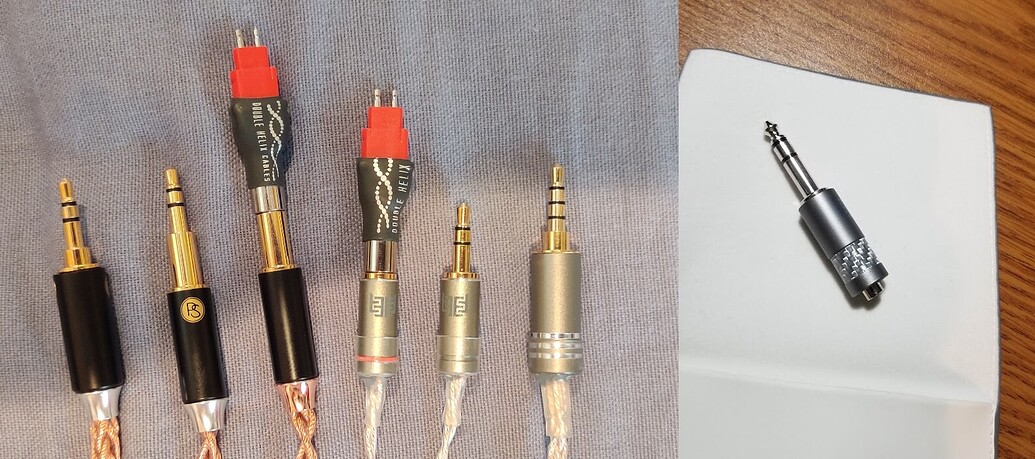
The more “discussed” half of a cable’s factor is the sonic equation. My stance originated from the thought that a solid Mogami or Canare cable would get you about 85% of the way there, and the rest is just final touches. As I tried more and more cables it seems that the percentage has changed or those final touches really start mattering more and more. These cables seem to represent the two further ends of the spectrum. The DHC ME representing a forward and pristine presentation, and the PlusSound X8 delivering a smooth, laidback take. The classic analytical vs relaxed battle. The DHC puts you in a high end studio. The walls are lined with deep noise dampening, a little compression is added, and everything you hear is highlighted, purposeful, and controlled. The X8 seems to put it all out there but doesn’t seem to care for tidiness and it felt closer to a live performance at your local coffee shop or bar. Echoes reverberate off walls covering over finer details, but giving the room shape and adding some extra emotion to the mix.
Both cables are extremely worthy contenders and they really give you a good sample of what an aftermarket cable can do. For my personal use case the PlusSound X8 really hit the spot. Although I wish it was as easily managed as the DHC ME, there was something about the sound that meshed so well with the portable setup. It was better able to take me away from the hustle and bustle of travel and work and relax me into groovin’. You can’t always pick your flight’s time, what seat you get, or why you always seem to be flanked by armrest hogs, but, you can pick the cable that helps take you far away from it all.
For Further Double Helix Cable Discussions…
For Further PlusSound Discussions…
For Further Focal Discussions…
Inching across the audio landscape in search of the coveted “Endless Groove”.
